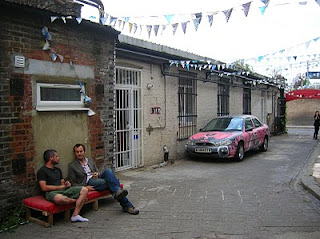Yesterday, Hackney Wick opened its doors, and artist's studios doors, to the other side of the world for a three-days art festival.
For a non-English mother-tongue obsessed with grasping every nuance of words' meaning, the name of the festival is a delightful and clever language game, swinging between "cool" and "bad": wicked. Very appropriate, if you consider that, as soon as you get off the overground, in normal days you would find yourself in the middle of nothing. Instead, the industrial and unattractive buildings (which, in fact, I find fab) are studios and homes for a large community of artists.
 It feels like landing in another world, which you have to explore just with the aid of the - few - tools in your possession (a map of the area highlighting the main events' location) and a good dose of interpersonal skills, especially in matter of orientation. The territory is not hostile of course, but you do feel like an outsider and start following the other +people, who know exactly where to go, like a stalker.
It feels like landing in another world, which you have to explore just with the aid of the - few - tools in your possession (a map of the area highlighting the main events' location) and a good dose of interpersonal skills, especially in matter of orientation. The territory is not hostile of course, but you do feel like an outsider and start following the other +people, who know exactly where to go, like a stalker.The many events were just unfolding around us, we could hear some music and percussion coming from the train station exit, and we had just missed our place at the dinner/performance organised by the curatorial collective Cosmicmegabrain. I just had the time to see one of the curators rushing to the terrace in Oslo House, wearing a shiny yellow foil hat with some flowers and cherries sprouting out of it. This is what I call landing on the job. After having bumped with pleasure in the only artist I know in the area (Martin Weswood, ndr), Habda and I ventured to see the studios and some art in the making. That was when I had the bohemian attack.

Known also as the Late Bohemian Sindrome, this rare and unlikely illness strikes subjects who are particularly sensitive to large, loft-like spaces, possibly with mezzanines, where art, great second-hand furnishings and private life are equally mixed. The first symptom is that the mind starts to wonder, imagining night parties like sin and a continuous, often stimulating confront with your neighboring peers. The attack carries on with drooling, a good dose of envy, loads of mental notes like the-day-I-will-have-my-own-house-I-must-remember-this-arrangement and, finally, it quickly fades away with the very down-to-earth thought: "But there is a common loo. No shower." The bohemian feeling lingers, though. The idea of something going on which maybe won't lead to the next generation of star artists to be born, but it will certainly be a tale to remember and tell: When I was twenty, I had a studio in Hackney Wick which I transformed into a living unit. I was painting everyday and partying every night - or the other way round -, we would talk a lot about art with the others and sometimes young critics and curators would join us. We organised shows and events, made things happen and... All right, I'll come off it. It just made me think that all the famous artists and curators we know must have started like this: with a beer, a romantic kennel and a good chat. That's what they must still be doing, actually.
Moving on, we managed not to miss Roberto Ekholm's performance The Magnetic Man inside the show La Perruque: inspired by Michel De Certeau's writings around cultural practices and relationships, the show tries to manipulate commonplaces and make them habitable, which is to say, to use your own creativity space into the rigid and framed working society.
The evening was concluded with a quick - rainy - shower and my venturing up an emergency iron ladder to go to one of the building's roof and have a glance at the city landscape. On the other side of the river, the Olympic Village is taking shape and I couldn't help but wonder what will it be of these guys once this is turned into a fashionable residential area. Below, lights were glowing from the opened spaces, with people milling around, commenting the latest works. Looking down, De Certeau sprung to mind again for his most famous writing about the practice of everyday life (1984): the city seen from above is the result of the institutionalised bodies, who organise it in a grid and try to direct the experience and gaze of the person traveling in it. Below, people continued to get lost or get rid of the map, following their instinct instead, enjoying the dérive.
The evening was concluded with a quick - rainy - shower and my venturing up an emergency iron ladder to go to one of the building's roof and have a glance at the city landscape. On the other side of the river, the Olympic Village is taking shape and I couldn't help but wonder what will it be of these guys once this is turned into a fashionable residential area. Below, lights were glowing from the opened spaces, with people milling around, commenting the latest works. Looking down, De Certeau sprung to mind again for his most famous writing about the practice of everyday life (1984): the city seen from above is the result of the institutionalised bodies, who organise it in a grid and try to direct the experience and gaze of the person traveling in it. Below, people continued to get lost or get rid of the map, following their instinct instead, enjoying the dérive.




No comments:
Post a Comment